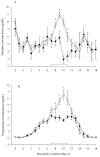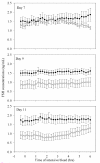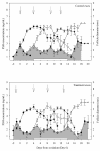LH pulse frequency and the emergence and growth of ovarian antral follicular waves in the ewe during the luteal phase of the estrous cycle
- PMID: 19638235
- PMCID: PMC2731046
- DOI: 10.1186/1477-7827-7-78
LH pulse frequency and the emergence and growth of ovarian antral follicular waves in the ewe during the luteal phase of the estrous cycle
Abstract
Background: In the ewe, ovarian antral follicles emerge or grow from a pool of 2-3 mm follicles in a wave like pattern, reaching greater than or equal to 5 mm in diameter before regression or ovulation. There are 3 or 4 such follicular waves during each estrous cycle. Each wave is preceded by a peak in serum FSH concentrations. The role of pulsatile LH in ovarian antral follicular emergence and growth is unclear; therefore, the purpose of the present study was to further define this role.
Methods: Ewes (n = 7) were given 200 ng of GnRH (IV) every hour for 96 h from Day 7 of the estrous cycle, to increase LH pulse frequency. Controls (n = 6) received saline. In a second study, ewes (n = 6) received subcutaneous progesterone-releasing implants for 10 days starting on Day 4 of the cycle, to decrease LH pulse frequency. Controls (n = 6) underwent sham surgery. Daily transrectal ovarian ultrasonography and blood sampling was performed on all ewes from the day of estrus to the day of ovulation at the end of the cycle of the study. At appropriate times, additional blood samples were taken every 12 minutes for 6 h and 36 min or 6 h in studies 1 and 2 respectively.
Results: The largest follicle of the follicular wave growing when GnRH treatment started, grew to a larger diameter than the equivalent wave in control ewes (P < 0.05). Mean serum estradiol and progesterone concentrations were higher but mean serum FSH concentrations were lower during GnRH treatment compared to control ewes (P < 0.05). The increased serum concentrations of estradiol and progesterone, in GnRH treated ewes, suppressed a peak in serum concentrations of FSH, causing a follicular wave to be missed. Treatment with progesterone decreased the frequency of LH pulses but did not have any influence on serum FSH concentrations or follicular waves.
Conclusion: We concluded that waves of ovarian follicular growth can occur at LH pulse frequencies lower than those seen in the luteal phase of the estrous cycle but frequencies seen in the follicular phase, when applied during the mid-luteal phase, in the presence of progesterone, do enhance follicular growth to resemble an ovulatory follicle, blocking the emergence of the next wave.
Figures









Similar articles
-
The temporal relationship between patterns of LH and FSH secretion, and development of ovulatory-sized follicles during the mid- to late-luteal phase of sheep.Theriogenology. 2005 Jul 15;64(2):393-407. doi: 10.1016/j.theriogenology.2004.12.006. Epub 2005 Jan 23. Theriogenology. 2005. PMID: 15955361
-
An ultrasound-aided study of temporal relationships between the patterns of LH/FSH secretion, development of ovulatory-sized antral follicles and formation of corpora lutea in ewes.Theriogenology. 2000 Jul 15;54(2):229-45. doi: 10.1016/s0093-691x(00)00344-7. Theriogenology. 2000. PMID: 11003304
-
Ovarian responses in gonadotrophin-releasing hormone-treated anoestrous ewes: follicular and endocrine correlates with luteal outcome.Reprod Fertil Dev. 2001;13(2-3):133-42. doi: 10.1071/rd00092. Reprod Fertil Dev. 2001. PMID: 11720130
-
Gonadotrophic control of follicular development and function during the oestrous cycle of the ewe.J Reprod Fertil Suppl. 1981;30:119-33. J Reprod Fertil Suppl. 1981. PMID: 6300383 Review.
-
Reproductive cycles in sheep.Anim Reprod Sci. 2011 Apr;124(3-4):259-68. doi: 10.1016/j.anireprosci.2011.02.024. Epub 2011 Feb 23. Anim Reprod Sci. 2011. PMID: 21411253 Review.
Cited by
-
Histological, immunohistochemical and serological investigations of the ovary during follicular phase of estrous cycle in Saidi sheep.BMC Vet Res. 2024 Mar 9;20(1):98. doi: 10.1186/s12917-024-03933-z. BMC Vet Res. 2024. PMID: 38461282 Free PMC article.
-
Ovarian stimulation by promoting basal follicular growth.Reprod Biol Endocrinol. 2025 Mar 6;23(1):35. doi: 10.1186/s12958-025-01356-5. Reprod Biol Endocrinol. 2025. PMID: 40050948 Free PMC article. Review.
-
Ovarian, uterine, and luteal vascular perfusions during follicular and luteal phases in the adult cyclic female rabbits with special orientation to their histological detection of hormone receptor.BMC Vet Res. 2022 Aug 4;18(1):301. doi: 10.1186/s12917-022-03390-6. BMC Vet Res. 2022. PMID: 35927671 Free PMC article.
References
-
- Bartlewski PM, Beard AP, Cook SJ, Chandolia RK, Honaramooz A, Rawlings NC. Ovarian antral follicular dynamics and their relationships with endocrine variables throughout the oestrous cycle in breeds of sheep differing in prolificacy. J Reprod Fertil. 1999;115:111–124. - PubMed
-
- Souza CJ, Campbell BK, Baird DT. Follicular dynamics and ovarian steroid secretion in sheep during anoestrus. J Reprod Fertil. 1996;108:101–106. - PubMed
Publication types
MeSH terms
Substances
LinkOut - more resources
Full Text Sources

